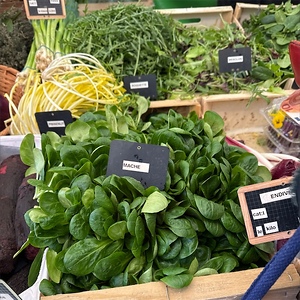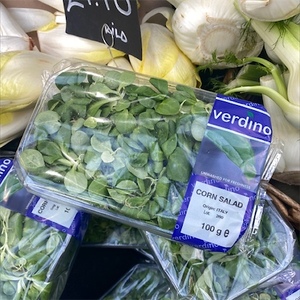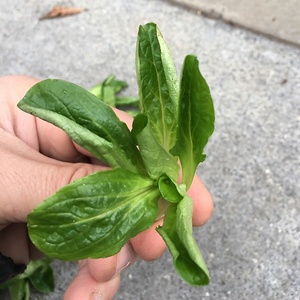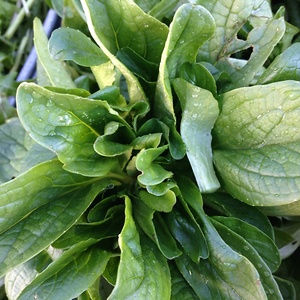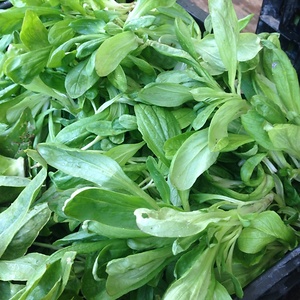

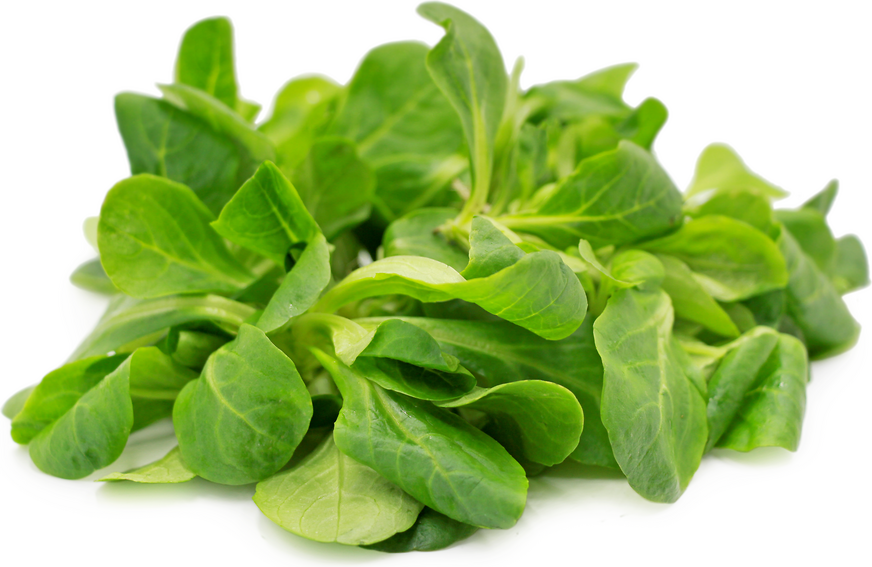
Mache
Estimated Inventory, lb : 0
Description/Taste
Mache is a small, low-growing plant that forms clustered rosettes reaching 10 to 30 centimeters in height. The rosettes are comprised of multiple loose layers of 6 to 8 elongated, rounded leaves, and depending on the variety, the leaves can appear more spoon-shaped, spatulate, to broad and slightly pointed. Mache leaves average 8 to 10 centimeters in length and are bright to dark green, depending on the variety, with a thin, pliable, and delicate, easily bruised nature. The leaf's surface will vary from smooth to textured with prominent veining, depending on the variety, and the edges of the leaves are even to semi-toothed. The stems are green, razor-thin, and tender. Select Mache with its rosette still intact, as whole plants last longer and will prevent the leaves from being damaged. If the rosette is not available, choose Mache leaves that are fresh and vivid green without any yellowing or transportation damage. Mache is edible when raw and has a soft, springy, succulent, tender, crisp, and velvety texture. The leaves release a mild, green, herbal, and nutty flavor with refreshing, tangy nuances. When cooked, Mache will mellow and mainly take on the taste of accompanying flavors.
Seasons/Availability
Mache can be grown year-round, with a peak season in the fall through mid-spring.
Current Facts
Mache, botanically classified as Valerianella locusta, is a low-growing, herbaceous plant belonging to the Caprifoliaceae family. The species has been growing wild since ancient times, but it wasn't until the 17th century that its reputation was transformed. Mache was once known as a humble weed, but when farmers began sowing the species in market gardens, the plant rose to the status of a specialty green. Mache is frost-tolerant to the point where it can be harvested frozen and still survive, and the plants were traditionally grown in the winter season when other delicate lettuce varieties could not survive. The leaves also remained tender, subtly sweet, and crisp throughout the winter, a welcomed flavor profile and texture amongst the chewier and more bitter winter brassicas. There are over two-hundred Mache varieties grown worldwide, each varying in flavor, quality, and hardiness, and there are two main seed types that have been developed in modern cultivation: small-seeded and large-seeded. Small-seeded Mache is typically grown in cold weather, while large-seeded Mache is cultivated in warmer months. Mache is also known by many regional names worldwide, and some of the more recognizable monikers include Lamb's Lettuce, Corn Salad, Vineyard Lettuce, Field Salad, and Vit. Mache received its Corn Salad moniker from its appearance in the rows of cereal crops in Europe, especially corn, wheat, and rye. The species also acquired its sheep-like title from the leaf's resemblance to the shape of a lamb's tongue. In the present day, Mache is a gourmet leafy green typically harvested by hand and is sold to chefs and home cooks as an elevated culinary ingredient for fresh or lightly cooked preparations.
Nutritional Value
Mache is a source of vitamin A to maintain healthy organ functioning, iron to develop the protein hemoglobin for oxygen transport through the bloodstream, and potassium to balance fluid levels within the body. The greens also provide vitamin C to strengthen the immune system while reducing inflammation, vitamin E to protect the cells against the damage caused by free radicals, magnesium to control optimal nerve functioning, copper to develop connective tissues, and other nutrients, including calcium, vitamin B6, folate, and phosphorus. In Europe, Mache was once used as a natural remedy to prevent scurvy. Sailors would consume the leaves to absorb the plant's high vitamin C content.
Applications
Mache has a tangy, succulent, green, and nutty taste suited for raw preparations. The greens must be thoroughly washed before consumption as they can hold particles of dirt and sand, similar to spinach. Once cleaned, Mache can be tossed into salads and is favored for its ability to hold dressings and oils on the leaf's deeply-veined surface, distributing flavor throughout the dish. The leaves are also used as an accouterment to appetizer plates and first courses or served fresh as a bed of greens for cooked meats and vegetable dishes. Try blending Mache into smoothies, layering the leaves into sandwiches for added crispness, or tucking the greens under scallops to enhance their delicate flavor. Mache can also be served as a simple side to foie gras, mixed into pasta, stirred into noodle and rice dishes, or used as a pizza topping. Though the leaves are not typically cooked, Mache is sometimes braised in light sauces, blended into dips and pastes, or simmered in soups, curries, and stews in Europe. The greens can also be quickly sauteed in fat and served with rich meat dishes. Mache pairs well with seafood such as fish, shrimp, crab, or scallops, fruits including strawberries, blueberries, apples, and grapefruit, nuts such as hazelnuts, almonds, pine, and walnuts, herbs including parsley, mint, and fennel, and springtime ingredients such as asparagus, ramps, morels, spring onions, and green garlic. Mache should be immediately used for the best quality and flavor. The greens will keep for 2 to 3 days when stored in a sealed container in the refrigerator's crisper drawer.
Ethnic/Cultural Info
Nantes, France, is a region renowned for its Mache production. The low-growing rosettes were first found in crop fields and vineyards and were cultivated in Nantes in the 17th century. Initially, Mache was grown for personal consumption in France, but as the plants were sown in larger fields, they became a crop selected for extensive cultivation. By the 19th century, Mache was a common crop in market gardens throughout the department of Loire-Atlantique in the Pays de la Loire region of western France. Nantes has sandy soil, a mild climate, and an ample water supply to nourish the greens, and the area produces approximately 85% of the total Mache grown in France. Mache is also known by many names in France, including Doucette, meaning "little sweet one," Clairette, Boursette, Galinette, and Blanchette, but within Nantes, it is famously known as Mâche Nantaise. This type of Mache has deeply veined, spoon-shaped leaves and is considered so unique to the region that it earned a Certification of Product Conformity or CCP in 1998 and a Protected Geographical Indication or PGI in 1999. On average, 30,000 tonnes of Mâche Nantaise is harvested each year in Nantes, and around one-third of that amount is exported to other countries throughout Europe, mainly Germany.
Geography/History
Mache is native to temperate regions of Europe, North Africa, and Western Asia and has been growing wild since ancient times. Within Europe, the species is thought to have first grown in the Mediterranean region and Caucasia, an area between the Caspian and Black Seas. Evidence of seeds was found in dwellings that date back to the Bronze and Neolithic Ages near Lake Zurich and Lake Constance, and experts hypothesize that the species was foraged as a wild food source in these periods. Mache was spread throughout Europe and North Africa, where the species was viewed as a wild, foraged plant in Ancient Egypt and Greece. Drawings of the plant have even been found in Egyptian tombs. Over time, Mache remained a wild plant and eventually developed a reputation for being a hardy weed that grew in agricultural fields. The plants were found between rows of crops in rye, corn, and wheat fields, and the French were credited with beginning large-scale cultivation of the species in the 17th century. Mache was eventually introduced from France to the United States, and Thomas Jefferson grew the plant in his Monticello Estate garden in the early 19th century. Mache later escaped cultivation in North America and became a naturalized species. Today Mache grows wild along rivers or lakes and in fields, home gardens, orchards, and vineyards. The species is foraged from wild plants, planted in home gardens, and commercially produced outdoors or in greenhouses for sale as a gourmet green in Europe, Asia, Africa, and North America. In the United States, Mache is primarily grown in the Salinas Valley in California. In France, Mache is produced in the departments of Loire-Atlantique, Vendee, and Maine-et-Loire.
Recipe Ideas
Recipes that include Mache. One



